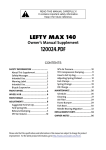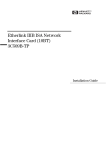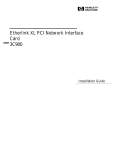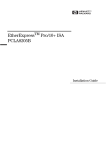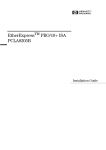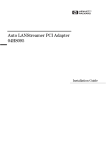Download KTI Networks KF223TX Network Card User Manual
Transcript
Installation Guide 10/100 Dual-speed Fast Ethernet PCI Adapters KF223TX, KF230TX DOC.971115-KF223/230TX-K P/N:750-0099-001 Ó 1997, KTI Networks Inc. All rights reserved. No part of this documentation may be reproduced in any form or by any means or used to make any directive work (such as translation or transformation) without permission from KTI Networks Inc. KTI Networks Inc. reserves the right to revise this documentation and to make changes in content from time to time without obligation on the part of KTI Networks Inc. to provide notification of such revision or change. For more information, contact: United States KTI Networks Inc. P.O. BOX 631008 Houston, Texas 77263-1008 Phone: 713-2663891 Fax: 713-2663893 BBS: 713-2663015 E-mail:[email protected] Web: http://www.ktinet.com/ International Fax: 886-2-6983873 BBS: 886-2-6983913 E-mail:[email protected] Web: http://www.ktinet.com.tw/ TRADEMARKS Ethernet is a registered trademark of Xerox Corp. NetWare is a registered trademark of Novell Inc. WARNING: This equipment has been tested and found to comply with the limits for a Class A digital device, pursuant to Part 15 of the FCC Rules. These limits are designed to provide reasonable protection against harmful interference when the equipment is operated in a commercial environment. This equipment generates, uses, and can radiate radio frequency energy and if not installed and used in accordance with the instruction manual may cause harmful interference in which case the user will be required to correct the interference at his own expense. NOTICE: (1)The changes or modifications not expressively approved by the party responsible for compliance could void the user's authority to operate the equipment. (2)Shielded interface cables and AC power cord, if any, must be used in order to comply with the emission limits. CISPR A COMPLIANCE: This device complies with EMC directive of the European Community and meets or exceeds the following technical standard. EN 55022 - Limits and Methods of Measurement of Radio Interference Characteristics of Information Technology Equipment. This device complies with CISPR Class A. WARNING: This is a Class A product. In a domestic environment this product may cause radio interference in which case the user may be required to take adequate measures. CE NOTICE Marking by the symbol CE indicates compliance of this equipment to the EMC directive of the European Community. Such marking is indicative that this equipment meets or exceeds the following technical standards: EN 55022: Limits and Methods of Measurement of Radio Interference characteristics of Information Technology Equipment. EN 50082/1:Generic Immunity Standard -Part 1: Domestic Commercial and Light Industry. EN 60555-2: Disturbances in supply systems caused by household appliances and similar electrical equipment - Part 2: Harmonics. 10/100BASE-TX FAST ETHERNET PCI ADAPTERS INSTALLATION GUIDE DOC.971114 DF223TX-KF230TX-NK P/N:750-0099-002 Table of Contents 1. Introduction 1.1 Adapter Features ................................................................ 1 1.2 Connector and LEDs ........................................................... 2 2. Installing the Adapter 2.1 Installing the Adapter .......................................................... 3 2.2 Connecting to the Network .................................................. 4 3. Network Driver Installation 3.1 Driver Information ................................................................. 7 3.2 PCI BIOS Setup .................................................................. 8 4. Setup Program and Diagnostics 4.1 Running Setup Program ...................................................... 9 4.2 Functions on the Main Menu ............................................. 12 5. LED Indicators 5.1 Interpretations ................................................................... 17 Appendix A.1 Specifications ................................................................... 18 A.2 RJ-45 Connectors & Cable ............................................... 19 A.3 Auto-negotiation Function ................................................. 20 A.4 Diagnostics Report ........................................................... 21 A.5 Installing Remote Boot ROM ............................................ 22 Figures Figure 1-1 Network Connector and LEDs .................................. 2 Figure 2-1 Inserting the Adapter into the PCI Slot ..................... 4 Figure 2-2 Network Connector ................................................... 4 Figure 2-3 Connecting 10BASE-T Cable ................................... 5 Figure 2-4 Connecting 100BASE-TX Cable ............................... 6 Figure 4-1 Main Menu of the Setup Program ............................. 9 Figure 4-2 Adapter Information ................................................. 11 Figure 4-3 DOS ODI Driver Installation Window ....................... 12 Figure 4-4 Setup Menu ............................................................ 13 Figure 4-5 Diagnostics Menu .................................................. 14 Figure A-1 RJ-45 Connector Pin Assignments ........................ 19 1. Introduction The 10/100BASE-TX Fast Ethernet PCI Adapter is a 32-bit LAN adapter for use in personal computers with PCI computer bus slots. This adapter is a dual-speed adapter and features one RJ-45 connector for either a 10 Mbps or a 100 Mbps IEEE 802.3 Ethernet network connection over unshielded twisted-pair (UTP) cable. The adapter automatically senses the connection speed, switches to either 10 Mbps or 100 Mbps and indicates the link status on the LEDs. 1.1 Adapter Features The features of the 10/100 Fast Ethernet PCI adapter are: • High performance bus master operation with low processor utilization • Automatically senses 10 Mbps or 100 Mbps connection • Supports auto-negotiation for the connection speed and duplex mode • PCI revision 2.0 or later compliance, 32-bit PCI half-card • Three status LEDs • Optional RPL Boot ROM for network operating systems • Supports 100BASE-TX connection with UTP Category 5 cabling • Supports 10BASE-T connection with UTP Category 3, 4, or 5 cabling • Setup software for quick driver installation and diagnostics 1 1.2 Connector and LEDs Figure 1-1 shows the connector and LEDs on the adapter. The following table describes these components. No. Components Description 1 10/100 Mbps This RJ-45 connector requires UTP network connector cable for 10Mbps or 100 Mbps connection. 2 100Mb Link LED This LED lights when 100 Mbps connection is selected and active. 3 10Mb Link LED This LED lights when 10 Mbps connection is selected and active. 4 Activity status LED This LED indicates a receive or a transmission is in process. Figure 1-1 Network Connector and LEDs 2 2. Installing the Adapter This chapter describes how to install the Fast Ethernet PCI adapter in a PCI computer and how to connect the adapter to the network. Before installing the adapter, you need the following: • A computer system that is compliant with the PCI specifications version 2.0 or later. • An available PCI bus master slot in the computer • The adapter driver diskette • UTP cables - use a UTP Category 5 cable with an RJ-45 plug to operate at 100 Mbps - use a UTP Category 3, 4, or 5 cable with an RJ-45 plug to operate at 10 Mbps 2.1 Installing the Adapter To install the adapter in your computer, follow these steps: 1. Turn off the power to the computer and disconnect all cables connected to the computer. 2. Remove the computer's cover. 3. Unscrew and remove the slot cover from the PCI bus master slot that you plan to use. 4. Install optional Boot ROM, if you want to use the remote boot ROM function. Refer to Appendix 5 for more information. 5. Insert the adapter into the slot and secure the screw (see Figure 2-1). 6. Replace the computer cover and reconnect all previously connected cables. 3 Figure 2-1 Inserting the Adapter into the PCI Slot 2.2 Connecting to the Network This section describes how to connect 10 Mbps or 100 Mbps network cables to the adapter. The rear bracket of the Fast Ethernet adapter contains one RJ-45 connector. The connector is used for either 100Mbps 100BASE-TX connection or 10Mbps 10BASE-T connection. The adapter can sense the connection speed and switch to appropriate operation automatically. Figure 2-2 Network Connector 4 10 Mbps Connection For 10BASE-T Ethernet networks, the Fast Ethernet adapter uses Category 3, 4, or 5 UTP cable. To establish a valid 10 Mbps connection, the cable must be connected to a 10BASE-T hub. Connect the network cable as follows: 1. Make sure that the plug on the cable is wired appropriately for a standard 10BASE-T adapter. 2. Align the RJ-45 plug on the end of the UTP cable with the notch on the adapter's connector and insert it into the adapter connector as shown in Figure 2-3. Figure 2-3 Connecting 10BASE-T Cable 5 100 Mbps Connection For 100BASE-TX Fast Ethernet networks, the adapter supports Category 5 UTP cabling. To establish a valid 100 Mbps connection, the cable must be connected to a 100BASE-TX hub. 1. Make sure that the plug on the cable is wired appropriately for a standard 100BASE-TX adapter. 2. Align the RJ-45 plug on the end of the UTP cable with the notch on the adapter's connector and insert it into the adapter connector as shown in Figure 2-4. Figure 2-4 Connecting 100BASE-TX Cable Note: The UTP wire pairs and configuration for 100BASE-TX cable are identical to those for 10BASE-T cable when used with Category 5 UTP cable. The straight through connection should be made from the adapter through the cable and connectors to the hub. Refer to Appendix A.1 for RJ-45 connector pin assignments. 6 3. Network Driver Installation After making the connection to the network, you must install the adapter network driver in order to connect the Fast Ethernet adapter to your network operating system. 3.1 Driver Information The adapter driver diskette contains the latest versions of the network drivers available when the adapter is shipped from the factory. A file, \README.DOC, located in the diskette's root directory contains a list of the supported driver software and the directory structures for the supported operating environments. Please refer to this file first before installing any network driver for the adapter. In the diskette, there are additional INSTALL.DOC files within the directory structures for each supported operating environment. These files contain information that pertains to the specified driver or operating environment that corresponds to the subdirectory where they are found. The basic drivers supplied in the adapter driver diskette are: • • • • • • • NetWare DOS ODI driver NetWare OS/2 ODI driver NetWare ODI server driver for NetWare 3.1x, 4.x, and Client32 DOS NDIS2 driver OS/2 NDIS2 driver NDIS3 driver for Windows NT NDIS3 driver for Windows 95 In addition to the basic drivers, more updated information and drivers 7 may be included in the driver diskette after this guide is published. Please refer to the \README.DOC file first for the latest information before you install any drivers. 3.2 PCI BIOS Setup Before installing the driver, it is recommended to run the system PCI BIOS setup utility to check each PCI slot that contains a Fast Ethernet PCI adapter for the following PCI settings: 1. Enable/disable the PCI slot : make sure the PCI slot is enabled for the adapter. 2. Assign an IRQ number : make sure the IRQ number does not conflict with other add-in adapters. 3. Enable bus mastering : the PCI slot must be enabled for bus mastering. On a PCI plug-and-play system, the PCI BIOS automatically configures the adapter, so there is no user action needed. Note: * When the PCI adapter is installed in some PCI computers with EISA slots, you must run the EISA configuration utility. If the utility is not available, consult your computer supplier. 8 4. Setup Program 4.1 Running Setup Program One setup program, SETUP.EXE, is contained in the adapter driver diskette. The Setup program is a DOS program for you to perform the following functions from its main menu as illustrated in Figure 4-1: Install menu: supports a quick method to install NetWare DOS ODI client driver on your computer. It also provides the instructions for installing drivers for various operating systems. Setup menu: enable full-duplex mode for Connectivity test. Diagnostics menu: performs diagnostic tests for the adapter. A Connectivity test is also provided in this menu for testing the network connection between two computers that each one is installed one PCI adapter. Figure 4-1 Main Menu of the Setup Program 9 You can run the program and perform the tests at any time after installing the adapter to verify the installation or you can run it when a fault is suspected. Before running the program Before running the setup program, make sure that the adapter is correctly installed in a computer with the PCI bus. The setup program must be run from the DOS prompt. When using the program to run diagnostics on the adapter, you should not load memory managers or other device drivers. To avoid this, press [F5] when DOS (version 6.x) loads, after the message "Starting MSDOS..." appears on the screen. This prevents the AUTOEXEC.BAT and CONFIG.SYS files from being executed. When the program is executed, it detects all installed Fast Ethernet PCI adapters in the computer and shows the basic information of the first adapter found. You may press [PgUp] key or [PgDn] key to browse the information of each adapter and select a target adapter to perform the optional tests shown on the main menu. Together with the SETUP.EXE, a SETUP.DOC file is also contained in the adapter driver diskette. It contains detailed information about this program. 10 Starting the Setup Program To start the Setup program, follow these steps: 1. Insert the adapter driver diskette labeled "1 of 2" into floppy disk drive A:. 2. Execute the following command from DOS prompt: A>SETUP <enter> A screen appears showing a menu bar on top of the screen and an information window for the first adapter found in the computer on the bottom portion of the screen as illustrated in the following figure: Figure 4-2 Adapter Information When Multiple Adapters are installed If multiple adapters are found, you may press [PgDn] or [PgUp] to browse the information of each adapter and select a adapter for the optional menus (Setup and Diagnostics). 11 4.2 Functions on the Main Menu This section describes the functions of "Install", "Setup", and "Diagnostics" menu on the main menu as follows: Running "Install" Menu The "Install" menu provides two functions as follows: • Install NetWare DOS ODI driver This function provides a convenient and quick method to install the Novell's NetWare DOS ODI driver for your computer without the need for Novell's installation diskettes. The pop-up window for the installation is illustrated in figure 4-3. Specify the parameters in the window for your environment and click [OK] to complete the installation. Figure 4-3 DOS ODI Driver Installation Window • Installation instructions for Other Network Operating Systems This function provides the helpful instructions for installing other drivers for various operating systems. 12 Running "Setup" Menu This menu allows you to configure full-duplex mode for the adapter before running Connectivity test. Figure 4-4 Setup Menu "Auto Detection" selection allows adapter to configure duplex mode automatically. "Full Duplex Enabled" selection will force the adapter to use full duplex mode. This setting will not be effective after any network driver is loaded or the computer is reboot. 13 Running "Diagnostics" Menu This menu provides two useful functions: Diagnostics and Connectivity test. Figure 4-5 Diagnostics Menu Diagnostics test function allows you to test the major components and verify the basic operations of the selected adapter. It performs many tests for the selected adapter and indicates the result of each test on a report window. Refer to Appendix 4 for more information. Connectivity Test allows you to test the adapter's ability to transmit and receive data while on the network. To run the test, you need a second computer set up as an echo station. The echo station receives packets from the adapter being tested and echoes (loopback) them back to the adapter over the network. 14 To set up an echo station, follow these steps: 1. Install another adapter which is known to have no problem into a second computer as instructed in Chapter 2. 2. Run SETUP.EXE on that computer. 3. Press [F10] and press [® ] to select "Diagnostics" from the main menu. 4. Select "Connectivity Test" and press [Enter]. 5. Select "Start Echo Station Test" from "Connectivity Test" pop-up window and press [OK]. The computer becomes an echo station. It will receive every packet with address 00 11 11 11 11 11 and echo the packets back to the adapter from which the packets were sent. You may start the Connectivity Test for the adapter after an echo station has been set up. Follow these steps: 1. Press [PgDn] or [PgUp] to select the adapter you want to test. 2. Press [F10] and press [® ] to select "Diagnostics" from the main menu. 3. To configure the number of packets to be performed for the "Network Link Test" in step 4, you may select "Test Configuration" item from the pop-up menu to enter the number: 15 4. Select "Connectivity Test" and press [Enter]. 5. Make sure an echo station is ready. Select "Start Network Link Test" from "Connectivity Test" pop-up window and press [OK] to start the test. A status window will report several packet counters as shown below: The "Transmit" counters indicate the number of good and bad packets which have been sent to the echo station. The "Receive" counters show the number of good and bad packets echoed back from the echo station. This test is also very useful in verifying a path between two computers on the network. 16 5. LED Indicators Each Fast Ethernet adapter has three LEDs, as shown in Figure 1-1. 5.1 Interpretations The interpretations of the LEDs are: 100Mb LED indicates an active 100Mbps connection is established. On : Good connection between adapter and 100BASE-TX hub Off : No connection between adapter and hub Blink: Not applicable 10Mb LED indicates an active 10 Mbps connection is established. On : Good connection between adapter and 10BASE-T hub Off : No connection between adapter and hub Blink : Not applicable Activity LED indicates packets are being received or transmitted. Blink : Network traffic is present On : Not applicable Off : No traffic for either speed If you experience any problems, first make sure that the appropriate driver is loaded, the proper cable is connected to the connector, and the hub complies with the adapter specifications (10 Mbps 10BASET or 100 Mbps 100BASE-TX). Then recheck the LED. 17 Appendix A1. Specifications Network std.: 10 Mbps IEEE 802.3 10BASE-T Ethernet 100 Mbps IEEE 802.3u 100BASE-TX Fast Ethernet Dimensions: MX98713 NIC KF223TX NIC RTL8139 NIC KF230TX NIC 80mm x 125mm (3.15" x 4.92") 80mm x 125mm (3.15" x 4.92") 50mm x 120mm (1.97" x 4.72") 50mm x 120mm (1.97" x 4.72") RTL8139 NIC 50mm x 120mm (1.97" x 4.72") KF230TX NIC 50mm x 120mm Environmental: Operating temperature 0o to 40oC Humidity 10% to 90% non-condensing Power: MX98713 NIC +5V 500mA max. KF223TX NIC +5V 500mA max. RTL8139 NIC +5V KF230TX NIC +5V 18 A2. RJ-45 Connector & Cables Figure A-1 shows the pin assignments of the RJ-45 connector for 10BASE-T and 100BASE-TX network. The pin assignments are identical for 10BASE-T and 100BASE-TX, using Category 5 UTP cable. Pin 1 2 3 4 5 6 7 8 Signal Name Transmit + Transmit Receive + NC (no connection) NC (no connection) Receive NC (no connection) NC (no connection) Figure A-1 RJ-45 Connector Pin Assignments Cabling Requirements: 10Mbps 10BASE-T Ethernet Category 3, 4, or 5 UTP Cable The maximum distance is 100 meters. 100 Mbps 100BASE-TX Ethernet Category 5 UTP Cable The maximum distance is 100 meters. 19 A.3 Auto-negotiation Function The adapter is equipped with an auto-negotiation function. Auto-negotiation is a negotiation procedure between two connected devices. Both devices must be auto-negotiation capable. The procedure decides the best operation modes that can be used for the data transfer operation between two connected devices. The operation modes includes connection speeds and duplex modes as follows: Connection speed : 10Mbps or 100Mbps Duplex mode : half-duplex or full-duplex Operating at full duplex can increase the network bandwidth to up to 20 Mbps or depending on the connection speed 200 Mbps. The following table describes how the adapter decides the operation modes when it connects to : An auto-negotiation device Speed: via auto-negotiation Duplex: via auto-negotiation A non-auto-negotiation device Speed: auto-sense the connection speed Duplex: half-duplex as default (*) * The default could be overwritten by configuration setting or keyword setting of each individual network driver when the driver is loaded. 20 A.4 Diagnostics Report When running "Diagnostics" from the SETUP program, the program indicates the result of each test on the Diagnostics Report window. Depending on the adapter model, the report window is shown as follows: MX98713 NIC RTL8139 NIC 21 A.5 Installing Remote Boot ROM Before you can use the remote boot function, you have to setup the remote boot service on the file server and install the remote boot ROM onto the adapter. To install the boot ROM, make sure the notch of the boot ROM is in the same direction as the notch of the socket on the adapter. The remote boot ROM socket is labeled U5 on the MX98713 NIC or it is labeled U2 on the RTL8139 NIC. Refer to the \BOOTROM subdirectory in the driver diskette for more detailed instructions on how to setup the remote boot service on a file server. 22



























